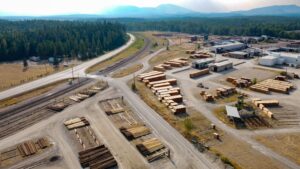
Did you know buildings account for 39% of global greenhouse gas emissions, surpassing even the transportation industry? Building Life Cycle Assessment (LCA) provides a structured, scientific methodology to measure and minimize these impacts, from raw material extraction and construction to eventual demolition or recycling. By enabling teams to pinpoint environmental hotspots and optimize decisions throughout the building lifecycle, LCA assessments have become pivotal for professionals committed to sustainable construction and significant environmental improvement. Here’s everything businesses must know to harness LCA effectively.
What is LCA Building & Why Does It Matter for Sustainable Construction?
Building Life Cycle Assessment (LCA) is a structured scientific methodology used to calculate the environmental impacts of a building project across its entire lifespan – from raw material extraction and construction through to usage, demolition, and recycling. By systematically evaluating each stage, LCA provides a comprehensive overview of how buildings contribute to environmental issues, guiding designers and builders toward sustainability improvements.
The importance of LCA is underscored by the significant role buildings play in global emissions. Currently, the construction sector is responsible for approximately 39% of global greenhouse gas emissions. LCA assessments help architects, engineers, and sustainability officers pinpoint precisely where these emissions originate, making it possible to target and significantly reduce them.
LCA building analyses go beyond merely measuring carbon footprints. They evaluate multiple environmental impact categories, including:
– Ozone depletion potential
– Acidification
– Resource depletion
– Water consumption
– Air and water pollution
– Waste generation
By assessing these diverse environmental factors, LCA provides a holistic view, essential for making informed decisions about materials, construction methods, and operational strategies.
For stakeholders committed to sustainable construction, implementing LCA is crucial. It not only helps achieve regulatory compliance and certifications like LEED or BREEAM but also empowers decision-makers to optimize the environmental performance of buildings. Through detailed insights gained from LCA, construction professionals can effectively mitigate ecological impacts, reduce operational costs, and drive meaningful progress toward net-zero and sustainability objectives.
The Four Essential Phases of LCA Building Analysis
Conducting a comprehensive structure environmental evaluation involves following a structured, four-phase process established by international LCA standards. Each phase plays a critical role in assessing and improving a building’s environmental performance throughout its complete lifecycle.
1. Goal and Scope Definition
Clearly defining objectives and boundaries for your architectural lifecycle analysis sets the foundation of your assessment. This initial phase involves determining the intended audience, aligning objectives with business goals or regulatory requirements, and specifying system limits – such as including only construction or also operational and demolition phases. Precise scope definition ensures accuracy and relevance, allowing decision-makers to target specific sustainability outcomes effectively.
2. Inventory Analysis (LCI)
During the Life Cycle Inventory phase, detailed data collection occurs. Analysts gather precise information on material quantities, transportation distances, construction equipment usage, energy consumption during construction and operational phases, water use, and waste generated. Accurate data collection at this stage is crucial, as this quantitative information directly influences the reliability of your final analysis results.
3. Impact Assessment (LCIA)
The third phase translates inventory data into specific environmental impacts. Analysts use standardized methodologies to quantify metrics like global warming potential, ozone depletion, acidification, eutrophication, and resource depletion. LCIA provides concrete, actionable insights, enabling architects, engineers, and sustainability officers to pinpoint hotspots in the building lifecycle that contribute most significantly to environmental impacts.
4. Interpretation of Results
The final phase involves reviewing and interpreting assessment findings. Analysts identify key results, validate data quality, and assess uncertainties and limitations within the study. This stage provides stakeholders with detailed, actionable recommendations to optimize sustainability outcomes. It also ensures transparency and reliability, supporting regulatory compliance, certification processes, and informed decision-making toward improved environmental performance.
Evaluating Environmental Impacts of Materials in LCA Building Studies

Evaluating building materials through Life Cycle Assessment (LCA) involves quantifying their environmental impacts across each stage of their lifecycle – from initial raw material extraction and production, through transportation, installation, use, maintenance, repair, and eventually recycling or disposal. These comprehensive evaluations typically leverage standardized documents called Environmental Product Declarations (EPDs), which provide transparent and comparable data on the ecological footprint of construction materials.
Material impact assessments within LCA studies empower architects, engineers, and construction managers to perform detailed comparisons between different material options. By identifying which materials contribute most significantly to embodied carbon – emissions resulting from manufacturing and supplying these products – teams can strategically choose sustainable alternatives and significantly lower the overall carbon footprint of their building projects.
An effective material impact assessment typically accounts for several key impact categories:
– Global Warming Potential (embodied carbon)
– Resource depletion
– Acidification potential
– Water usage
– Ozone depletion potential
These insights enable targeted optimization of material selection, guiding decision-makers toward products with lower environmental consequences and greater sustainability performance. For example, replacing conventional concrete with low-carbon concrete or sustainably sourced timber can substantially reduce embodied emissions and conserve resources.
By systematically quantifying and comparing the environmental impacts associated with different construction materials, LCA provides construction professionals with actionable data. This helps them comply with increasingly strict sustainability regulations, meet green building certification requirements such as LEED or BREEAM, and fulfill company-wide sustainability targets.
Applying LCA Building Principles Across Construction, Operation & Demolition Phases
Life Cycle Assessment (LCA) provides a structured approach for evaluating the environmental impacts of buildings throughout their complete lifecycle – from raw material extraction to final demolition and recycling. A comprehensive LCA considers each phase separately, pinpointing opportunities for sustainability improvements at every step.
During the construction phase environmental assessment, analysts measure impacts associated with transporting materials, operating heavy construction equipment, energy consumption on-site, and waste management practices. For example, transportation to project sites often contributes significantly to carbon emissions, so selecting locally sourced materials can substantially reduce environmental impacts. Additionally, implementing effective waste management strategies, such as recycling construction materials and minimizing landfill disposal, further reduces the ecological footprint.
Operational phase life cycle scrutiny involves assessing resource use and environmental impacts during a building’s active use period. Key areas include energy and water consumption, emissions from heating and cooling systems, ongoing maintenance activities, and repair or replacement of building components over time. Energy-efficient building designs, renewable energy sources, and water conservation measures can significantly lower operational emissions and resource use. Continuous monitoring and optimization of building systems throughout this phase helps maintain long-term environmental performance.
The demolition and deconstruction environmental review evaluates the end-of-life impacts of a building, including waste generation, recycling potential, disposal methods, and possible reuse of building components. Demolition activities often result in substantial waste streams, but careful planning and selective deconstruction methods can maximize recycling and reuse opportunities. Choosing recyclable materials from the outset simplifies end-of-life processing and minimizes negative impacts. Effective demolition phase strategies not only reduce waste but also provide valuable materials that can return to the supply chain, supporting circular economy principles and enhancing overall sustainability.
How Innovative LCA Software Streamlines Building Sustainability Assessments
Traditionally, conducting detailed Life Cycle Assessments (LCAs) for buildings involved extensive manual calculations and intensive data collection, making the process resource-intensive and inaccessible for many projects. Today, innovative LCA software for architecture transforms these assessments, significantly enhancing precision and efficiency while reducing complexity.
Digital LCA solutions for construction, such as Athena Impact Estimator, Tally, and One-Click LCA, simplify the evaluation of building materials and processes. These tools feature intuitive, user-friendly interfaces that allow sustainability officers, architects, and project managers to quickly model different construction scenarios and assess their environmental impacts. With built-in scenario analysis capabilities, stakeholders can easily compare design options, material choices, and construction methods to identify the lowest-impact alternatives.
The core strength of eco performance modeling tools lies in their robust databases. These platforms integrate extensive, pre-populated environmental databases containing precise environmental impact data for various building products, materials, and systems. By automating data collection processes, software solutions eliminate the manual effort of gathering and verifying environmental data, substantially shortening the time required for a full building assessment.
Modern LCA software also seamlessly integrates project-specific data – such as Bills of Materials (BOM), energy performance calculations, and site-specific variables. This automation ensures accuracy and consistency in the LCA outputs, aligning closely with actual project conditions. By streamlining data integration, these tools empower teams to rapidly generate comprehensive, transparent sustainability assessments that comply with widely recognized standards and certifications like LEED and BREEAM.
Innovative LCA software for architecture reduces barriers to sustainable construction by democratizing access to detailed sustainability assessments. With increased accessibility and ease of use, more construction projects can effectively implement LCA methodologies, driving significant environmental improvements across the built environment.
Regulatory Compliance & Environmental Reporting through LCA Building Practices
Life Cycle Assessment (LCA) plays a central role in ensuring regulatory compliance in building assessment. By adhering to recognized standards such as ISO 14040/14044 and EN 15804 for Environmental Product Declarations (EPDs), construction professionals demonstrate rigorous commitment to transparency and sustainability. These standardized frameworks provide clear guidelines for quantifying and documenting environmental impacts throughout the building lifecycle, significantly streamlining environmental reporting for structures.
Green certification lifecycle evidence is increasingly required in building projects, especially with recent updates to certification schemes. For example, LEED v5 places a strong emphasis on embodied carbon reporting, making comprehensive LCAs not just beneficial, but essential for achieving desired sustainability ratings. Similarly, BREEAM certification recognizes detailed lifecycle assessments as integral to transparent environmental performance evaluations.
Implementing LCA methodologies also ensures alignment with regulatory directives like the EU’s Construction Products Regulation (CPR), further bolstering compliance efforts. Robust and verifiable environmental data generated through LCAs strengthen stakeholder trust, enhance market positioning, and proactively address evolving regulatory landscapes. Organizations that integrate LCA into their standard practices position themselves favorably, effectively leveraging sustainability as a competitive advantage.
Best Practices for Implementing LCA Building Assessments Effectively
Effective LCA building assessments require clear definitions and accurate data to optimize sustainable project outcomes. Start by precisely defining your LCA goals, scope, and system boundaries. Aligning these elements early ensures your assessment targets relevant performance indicators for sustainable projects – such as embodied carbon, resource efficiency, and waste reduction – providing clarity for stakeholders and improving decision-making.
When performing building impact assessments, always prioritize the use of manufacturer-specific Environmental Product Declarations (EPDs) over generic industry averages. Manufacturer-specific EPDs offer more precise and transparent data concerning material sourcing, production processes, and transportation, enabling more accurate sustainability evaluations. This granular level of detail reduces uncertainty and enhances the credibility of your findings, supporting robust sustainability claims and regulatory compliance.
Regular stakeholder engagement is another key best practice in sustainable structure lifecycle assessments. Engage architects, engineers, suppliers, and project managers through frequent communication and transparent data sharing. By involving stakeholders throughout the assessment process, you encourage collaboration, build trust, and streamline decision-making – ensuring all parties understand and commit to sustainability objectives.
Finally, consistent documentation and transparency in your LCA data collection and analysis are critical. Transparent reporting methods enable verifiable comparisons, support third-party audits, and facilitate compliance with industry standards such as ISO 14040/14044 and green building certifications (e.g., LEED, BREEAM). Clear documentation also empowers continuous improvement, enabling stakeholders to track progress toward ambitious sustainability targets over the project’s lifecycle.
Real-World Case Studies: Successful Applications of LCA Building Methodologies
Real-world case studies provide concrete demonstrations of how companies leverage Life Cycle Assessment (LCA) methodologies in construction to significantly lower environmental impacts and streamline compliance with sustainability standards.
For instance, Skanska, a global construction firm, successfully used comprehensive building performance life cycle assessments to reduce embodied carbon in their projects by as much as 30%. By meticulously evaluating construction materials and processes through LCA, Skanska identified key carbon-intensive materials and replaced them with lower-impact alternatives. This approach not only reduced emissions but also enhanced their competitive advantage, positioning the company as a sustainability leader within the industry.
Similarly, multinational architecture firm Perkins&Will benchmarked sustainable building practices by integrating LCAs into the early design phase of their projects. Utilizing detailed LCA data, Perkins&Will optimized building layouts, material selection, and energy systems, achieving LEED Platinum certifications consistently across multiple projects. This proactive integration of LCA into the design process simplified compliance and showcased tangible sustainability achievements to stakeholders.
Another compelling example is the Edge building in Amsterdam, developed by OVG Real Estate, which harnessed LCA to set new standards for sustainability metrics. The comprehensive LCA analysis informed decisions on energy use, water management, and material sourcing. The outcome was a building with a 40% reduction in energy consumption and a record-breaking BREEAM Outstanding certification score. This achievement clearly demonstrates the strategic business value of embedding LCA methodologies directly into project planning and execution.
These case studies underscore how actionable insights from LCA analyses can translate into measurable sustainability outcomes, regulatory compliance, and enhanced market positioning. By systematically applying LCA, industry leaders effectively quantify environmental impacts, optimize resource use, and advance sustainable construction practices.
Final Words
Implementing LCA building methodologies empowers architects, engineers, and sustainability managers to accurately measure and minimize a structure’s environmental impact throughout its entire lifecycle.
From informed material selection and lifecycle stage evaluations to streamlined reporting and regulatory compliance – building life cycle assessments serve as a strategic framework for sustainable construction.
By utilizing the precise insights offered by lca building processes, construction stakeholders can confidently advance toward meaningful sustainability targets, positively influencing our built environment for future generations.
FAQs on LCA building
Q: What is a building Life Cycle Assessment (LCA)?
A: A building Life Cycle Assessment (LCA) is a structured methodology that evaluates environmental impacts throughout a building’s lifecycle – from materials extraction and construction to operation, demolition, and recycling – to help optimize sustainability and reduce emissions.
Q: What does LCA stand for in architecture?
A: In architecture, LCA stands for “Life Cycle Assessment,” referring to the systematic evaluation of environmental impacts associated with buildings across their entire lifecycle, including production, use, and disposal stages.
Q: Why is LCA crucial for sustainable construction?
A: LCA is crucial for sustainable construction because buildings generate approximately 39% of global greenhouse gas emissions, and LCA enables architects and engineers to quantify these impacts – providing data to effectively reduce emissions and pursue sustainability targets.
Q: How much does performing a building LCA cost?
A: The cost of performing a building LCA varies depending on project scope, complexity, and software usage. Modern LCA tools like One Click LCA streamline and automate calculations, significantly reducing time, complexity, and overall assessment costs.
Q: What are the best software tools for building LCA analyses?
A: Leading software tools for building LCA analyses include One Click LCA, Athena Impact Estimator, and Tally. These solutions offer user-friendly interfaces, comprehensive environmental databases, automated scenario modeling, and integration capabilities for streamlined impact assessments.
Q: How does building LCA software benefit architects and sustainability managers?
A: Building LCA software provides architects and sustainability managers with detailed environmental insights, facilitates accurate reporting, ensures compliance with regulatory standards, optimizes sustainable material choices, and significantly speeds up the assessment process through automation.



